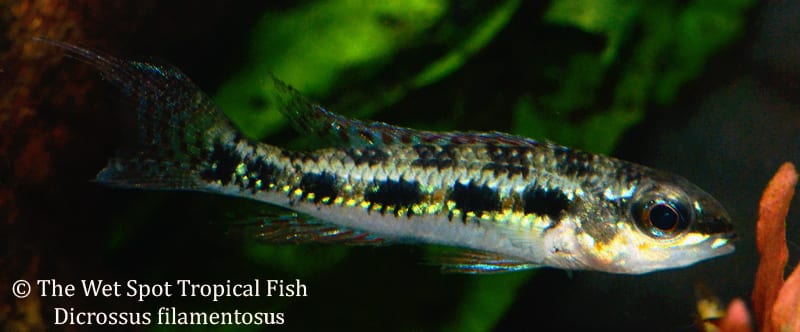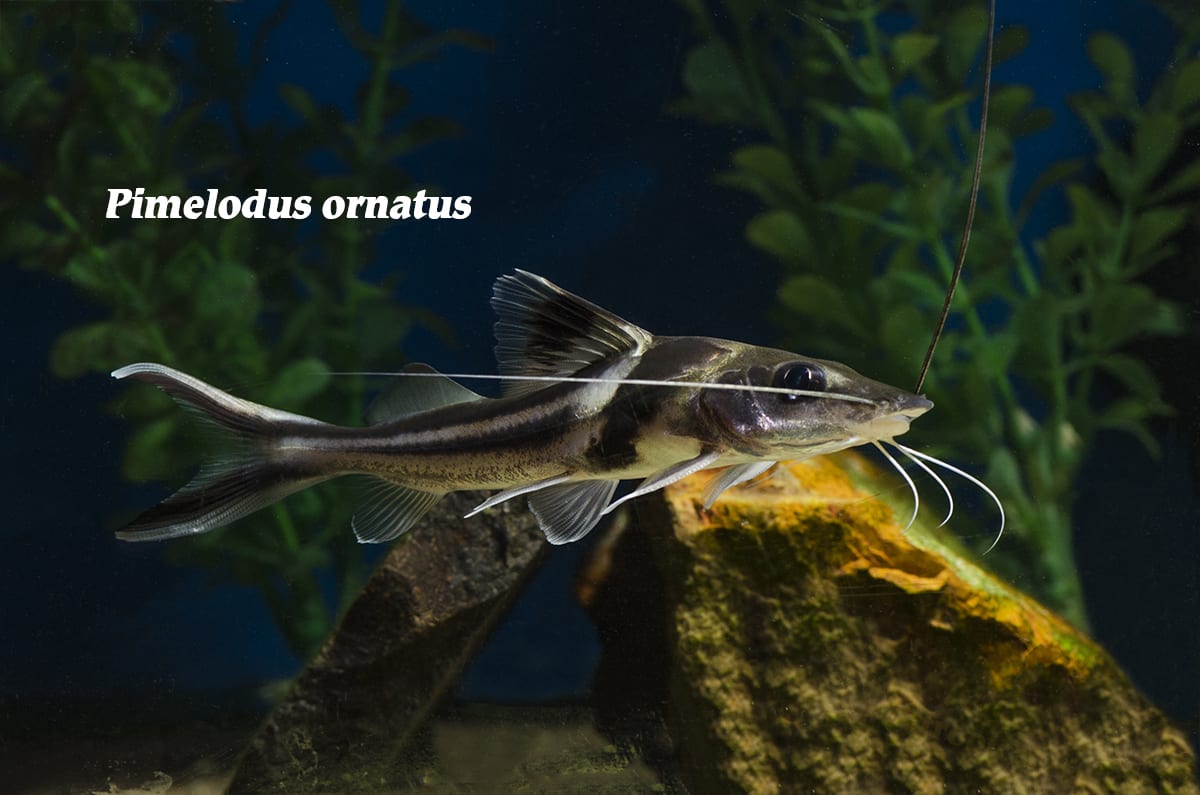Fish or Treat
Fish or Treat
Well, it’s the week of Halloween already, and now begins the panicked scramble to improvise final costumes. Lucky for us at the Wet Spot, we have inspiration aplenty every time we pass our tanks. This week we thought we’d help out our favorite fish lovers and share some of our top fashionista fish. Braving the halloween party waters in getups resembling Nannostomus espei, Dicrossus filamentosus, or Pimelodus ornatus is bound to pay off in costume party gold.
Scientific NameNannostomus espei
Common NameBarred pencilfish
Temperature / pH72 to 83°F / 4.0 to 6.5 pH
Native LocationGuyana
Preferred DietSmall invertebrates
Dedicated to their costumes, N. espei, also known as “Barred Pencilfish” display a 5 black vertical bar pattern on shimmering golden bodies all day. We’ll take our lead from other Nannostomus spp. that mimic this pattern only at night. Eerily inhabiting blackwater habitats of Guyana, these pencilfish are often found in densely vegetative slow-moving streams and swamps with tannin-stained waters. In captivity, they do best in setups with sponge filtration. dark, sandy substrate, driftwood branches, logs, and tangles, floating plants, and decaying leaf litter. Microbe colonies thriving on this litter provides a secondary food source. In the wild, they chow down on zooplankton and invertebrates. In captivity they will accept high quality dried flake with daily snacks of live, frozen, and freeze dried delicacies. Reaching just 1 inch in length, these pencilfish are timid and vulnerable to more aggressive tank mates. As schooling fish, they feel most comfortable housed in single species tanks in groups of at least a dozen. Some aquarists have success, however, keeping them in tanks with small Loricariid Catfish, non-aggressive Characins, and Dwarf Cichlids. Barred Pencilfish do best in waters with temperatures between 72 and 83°F, pH of 4.0 to 6.5, and hardness between 18 and 90 ppm.
Scientific NameDicrossus filamentosus
Common NameCheckerboard Cichlid
Temperature / pH79 to 82°F / 4.0 to 6.5 pH
Native LocationBrazil
Preferred DietSmall invertebrates
Found in small forest streams of the Rio Orinoco and Rio Negro of Brazil, D. filamentosus is the life of the party. This “Checkerboard Cichlid” has it all, big personality, bold pattern, and bright coloration. Males reach just over 3 inches in length and exhibit copper coloration with 2 rows of blocked black spots in checkerboard pattern which change shape and configuration with their mood. During mating, males’ ventral fins become red and blue striped. Females are a bit smaller, reaching 2 inches in length, and exhibit solid salmon-red ventral fins during spawning. Requiring less space than other cichlids of their caliber, they can be housed in tanks with shallower depths if it is sufficiently wide. Tanks should be equipped with good filtration units,dark substrate, large pieces of dark driftwood, and plentiful hiding places and furnishings of the aquarists choosing. They are best kept in conspecific groups of 12 or more, and can be kept alongside Apistos, other Dwarf Cichlids, and small Characins. These small Checkerboard Cichlids has small mouths, and should only be fed small bites of brine shrimp or mosquito larvae, and high quality dried foods. Tank waters should be maintained with temperatures between 79 and 82°F, pH of 4.0 to 6.5, and hardness below 36 ppm.
Scientific NamePimelodus ornatus
Common NameOrnate Pim
Temperature / pH75 to 77°F / 6.0 to 7.2 pH
Native LocationNorthern South America
Preferred DietCarnivorous
Thinking about breaking out the cat costume? Add a unique spin, and go catfish! There’s no better candidate than P. ornatus. Also known as the “Ornate Pimelodus Catfish”, this medium-sized predatory catfish is copper with a bluish sheen, and exhibits black vertical and horizontal banding, a white belly, big eyes, and long whiskers extending off a flattened snout. These catfish are quite active swimmers and require larger tanks with lots of free space, gravel substrate, floating plants, and lots of shady refuges. Widely distributed across streams of northern South America in riverbeds, upstream, and downstream rapids, in backwater zones, and in stony bottom pools. Extremely hardy and resourceful, they are predatory consuming large amounts of fish at once inflating their bellies to marble-size, which they can live off of for many days. In captivity they can be fed large amounts of bloodworm, and other live and frozen foods. The stuff of nightmares, these catfish secrete toxic mucus and use spiny fins to injure their prey. Thus, they should not be kept in community tanks with small fish. They do well alongside larger and more active fish like Barbs, Gouramis, and Tetras. Waters should be kept with temperatures of 75 to 77°F, pH between 6.0 and 7.2, and hardness of 128 ppm or less.
Looking for the perfect contest-winning unique costume? Check out our fish lists, photo galleries, or give us a call! We’ve got your perfect muse whether you’re costuming in schools or swimming solo.


